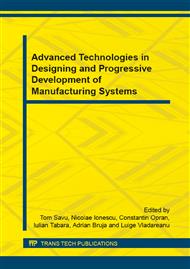p.527
p.533
p.539
p.545
p.551
p.557
p.563
p.571
p.577
Surface Roughness at Wire Electrical Discharge Machining
Abstract:
Wire electrical discharge machining is a machining method by which parts having various contours could be detached from plate workpieces. The method uses the electrical discharges developed between the workpiece and the wire tool electrode found in an axial motion, when in the work zone a dielectric fluid is recirculated. In order to highlight the influence exerted by some input process factors on the surface roughness parameter Ra in case of a workpiece made of an alloyed steel, a factorial experiment with six independent variables at two variation levels was designed and materialized. As input factors, one used the workpiece thickness, pulse on time, pulse off-time, wire axial tensile force, current intensity average amplitude defined by setting button position and travelling wire electrode speed. By mathematical processing of the experimental results, empirical models were established. Om the base of a power type empirical model, graphical representations aiming to highlight the influence of some input factors on the surface roughness parameter Ra were achieved. The power type empirical model facilitated establishing of order of factors able to exert influence on the surface roughness parameter Ra at wire electrical discharge machining.
Info:
Periodical:
Pages:
551-556
Citation:
Online since:
May 2015
Price:
Сopyright:
© 2015 Trans Tech Publications Ltd. All Rights Reserved
Share:
Citation:


